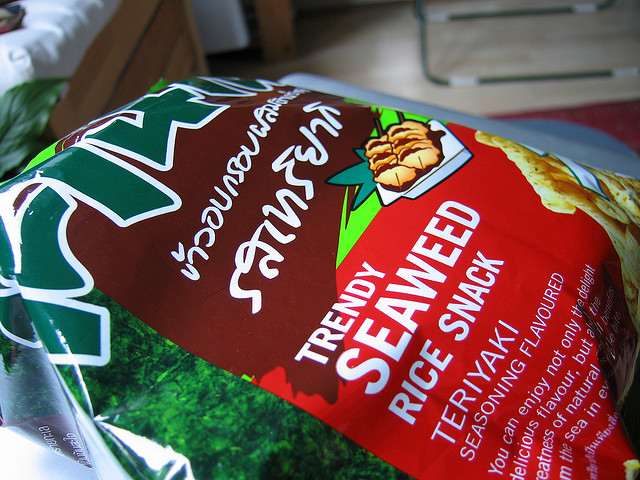Roasted and salted seaweed, traditionally eaten with rice in Asia, has become a popular snack food outside of the region. Being from Korea, I was astonished when I first encountered teriyaki-flavored seaweed and varieties that were mixed with almonds here in the U.S.—quite a difference from what I used to enjoy growing up, which was merely oil-roasted and slightly salted.
The sudden popularity of such dried, packaged seaweed snacks have led exports of seaweed, or gim as it is called in Korean, to surge. While many people know that the surname “Kim” is quite a ubiquitous Korean name (in fact one-fifth of the South Korean population are Kims), not many foreigners realize that it is pronounced “gim” just like the word for seaweed. The origin of the name is said to be from a Kim family that first started farming gim in the 17th century.
Nori, as seaweed is called in Japan (or zicài in China), has been cherished as a luxury food for hundreds of years. It is high in fiber and iodine, and has been used extensively in many cuisines since Japan invented a modern aquaculture method of cultivating the algae in the 1920s.
These days the Korean variety of edible seaweed is generally recognized as a superior quality product over seaweed produced in China, and tends to be more competitively priced than Japanese nori. Korea has produced more seaweed than Japan since 2011, and in fact also exports seaweed to Japan. The biggest overseas demand for Korean seaweed, however, comes from the U.S., which bought approximately US$64 million of the export in 2013, a whopping US$47 million more than it did in 2009. That is dwarfed by the country’s many tens of billions of dollars in exports of smartphones or automobiles, but seaweed still tops the list among U.S.-bound food exports, outpacing cigarettes, beverages and ramen.
With the consumption of seaweed gradually expanding to non-Asian consumers, seaweed products have received notable attention in new circles, and are frequently marketed as a healthy and tasty snack for the entire family. Major U.S. food retailers have even recently begun to launch private label seaweed products, and offer an increasingly wide range of variations.
Along with the U.S., Thailand, Canada, Russia, the United Kingdom, Brazil, and the United Arab Emirates are all seeing a big increase in such snack seaweed imports. It is interesting to see a food previously served only among particular populations or regions gaining global exposure. The ways in which the global food culture is evolving appears to be as dynamic as the evolution of global economies and industries.
Article by Soo Chang Lee, Research Analyst, Matthews Asia.
The views and information discussed represent opinion and an assessment of market conditions at a specific point in time that are subject to change. It should not be relied upon as a recommendation to buy and sell particular securities or markets in general. The subject matter contained herein has been derived from several sources believed to be reliable and accurate at the time of compilation. Matthews International Capital Management, LLC does not accept any liability for losses either direct or consequential caused by the use of this information. Investing in international and emerging markets may involve additional risks, such as social and political instability, market illiquidity, exchange-rate fluctuations, a high level of volatility and limited regulation. In addition, single-country funds may be subject to a higher degree of market risk than diversified funds because of concentration in a specific geographic location. Investing in small- and mid-size companies is more risky than investing in large companies, as they may be more volatile and less liquid than large companies. This document has not been reviewed or approved by any regulatory body.


